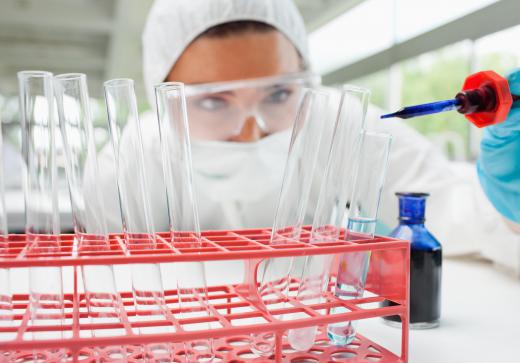What Is Proximate Analysis?
Proximate analysis is a type of scientific inquiry done to determine the approximate amounts of substances within a material. This is utilized by different types of scientists to study such things as animal feed, coal, and bio-fuels. The process of proximate analysis is complicated and often involves either extraction or remote sensing to determine the varying amount of substances within one material, though different methods are used for different materials. This information can be used to create quality controls for various materials, ensure that they do not contain hazardous chemicals, and determine whether they are healthy enough to be consumed by humans or animals.
Scientist begin proximate analysis by getting a sample of the material ready to use. The size of the sample and the methods for readying it vary depending on the type of material being analyzed. Once the material has been readied, the sample is analyzed using one of a few recognized techniques. Extraction is a means of utilizing additional substances and chemicals to bring certain substance out of the material so that they can be examined and measured. Remote sensing uses machines and robots to examine the material and estimate of which it is composed.

After the sample has been analyzed using one of these techniques, an analysis of the components can be done. Analysis is performed using both qualitative and quantitative techniques to form measurements and provide scientists with answers to their questions. The precise instruments used for analysis depend on the sample being tested and the goals of the scientists in the experiment.
One major goal of proximate analysis is to determine if there are hazardous substances in a sample of material. In such industries as oil and coal, this can determine whether the item is safe to be used in vehicles or burnt, respectively. Environmental regulations require that this information is tested to ensure that dangerous fumes are not entering into the atmosphere over a certain predetermined level. The materials must have certain substances in them in order to pass the quality control standards that are heavily regulated in most countries.
Another major use of proximate analysis is to find out if food items are safe for human and animal consumption. For livestock, feed is tested to ensure that it contains enough protein, fats, and carbohydrates for healthy animals. In human food, nutrient levels are tested to determine the levels of each within the product, as well as such things as protein, fats, and carbohydrates.
AS FEATURED ON:
AS FEATURED ON:











Discussion Comments
@miriam98 - I think that we need more of this sampling done in our water supplies. The government may insist it's being done but our tap water is simply not safe enough to drink, if current studies are any indication.
While I don’t know of people falling deathly ill from drinking tap water, I have heard of people getting stomach viruses and other forms of bacteria. When they switched to filtered water the problems went away along with simply getting better tasting water.
@NathanG - I don’t see why they can’t do larger sample sizes frankly. According to the article this is certainly possible. Plus, let’s not forget the fact that robots can work in an assembly line to do sampling.
Is it so hard to have robots sample every piece of meat that goes through the meat factory? Robots never get tired and I think the analysis can be conducted quickly, providing real time results.
I can’t say I share your defense of the fast food industry in this regard. They can do more to ensure that the food they put out is healthful, without hurting their profits.
The key word in proximate analysis is “sample.” A sample is just a representation of a larger population. For many applications, it is not practicable to conduct the analysis on the whole population.
This is why we wind up with unfortunate occurrences of E Coli outbreak in fast food every now and then, and even in some restaurant meats. There is understandably an outrage from the public and I don’t fault them for that.
I do think that people are being unreasonable when they insist that every piece of meat be inspected. It’s just not possible in a way to continue to do business efficiently, especially with the demands being imposed on the fast food industry.
Post your comments